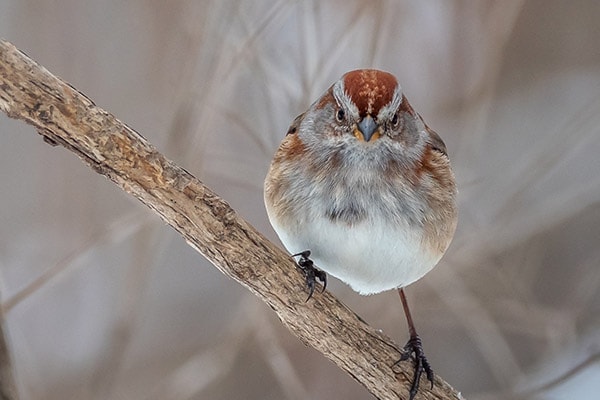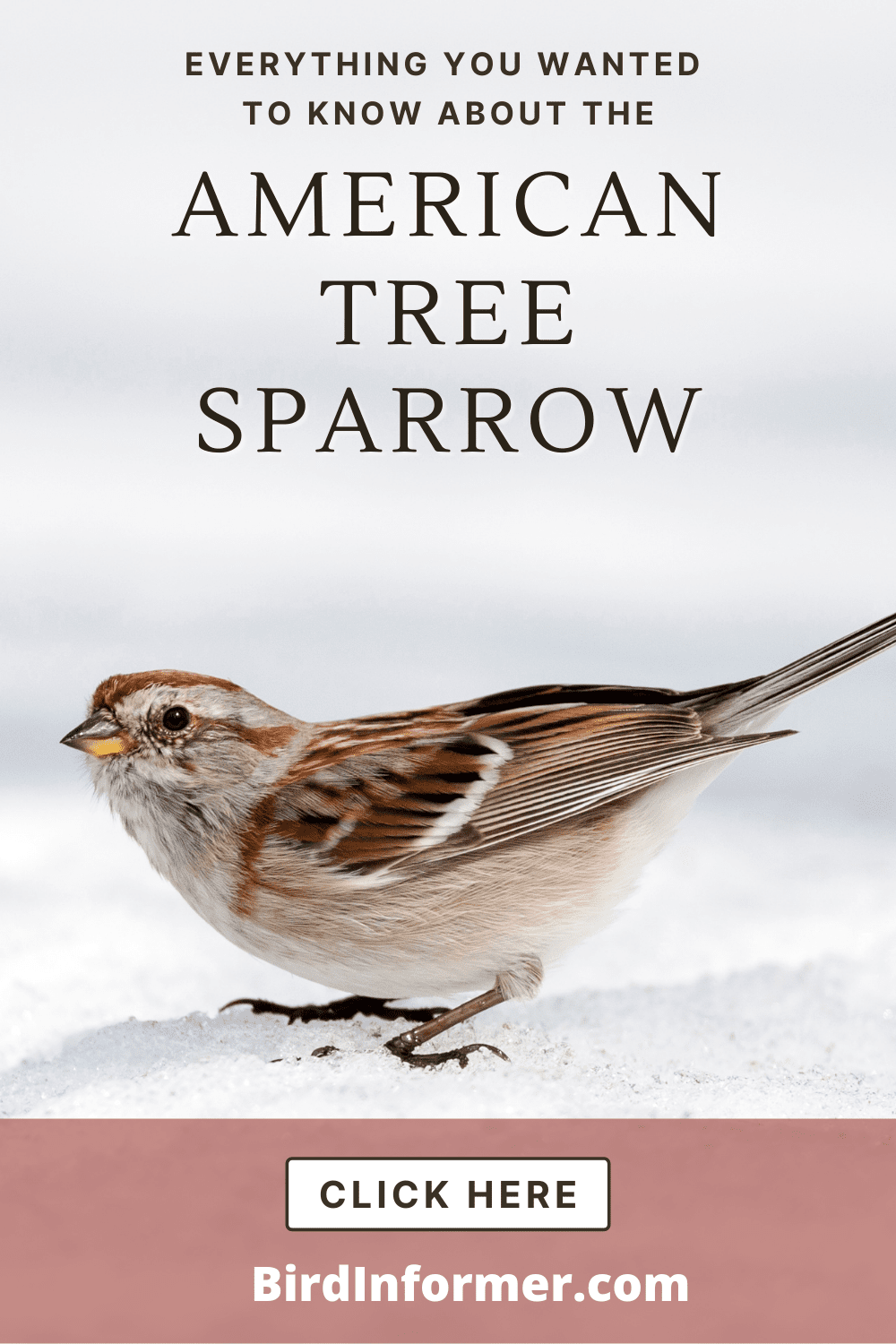Contents
- American tree sparrow facts
- American tree sparrow: how-to identify
- American tree sparrow bird vocalization
- Where You’ll See American Tree Sparrows
- American tree sparrow diet
- American tree sparrow nesting
- American tree sparrow behavior
- How-to attract american tree sparrows
- American tree sparrow threats
- American tree sparrow fun & interesting facts
- American tree sparrow related species in this family
American Tree Sparrows are small birds with round bodies and long tails. Both male and female birds look very similar with their brown cap, plain gray bodies, and recognizable dot on their chest. These birds are commonly found throughout Alaska or the far north areas but are frequent visitors in southern Canada and the northern US during winter.
In this article, we are going to cover a wide variety of topics related to the American Tree Sparrow, such as:
- How to identify them
- How, when, and where they migrate
- Their diet
- How and where they nest
- And much more…
So, without any more delay…
Let’s jump right into it and learn more about the American Tree Sparrow.
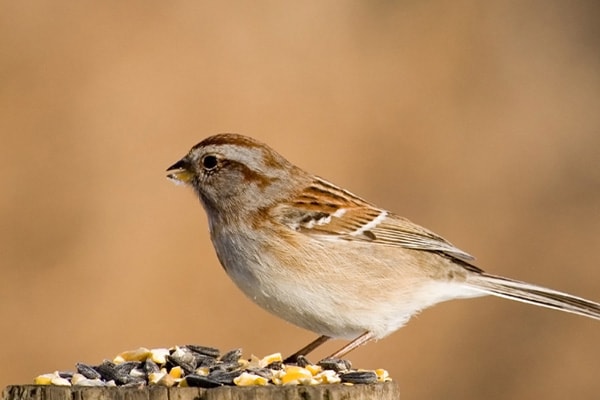
American tree sparrow facts
- Common Name: American Tree Sparrow
- Scientific Name: Spizelloides arborea
- Scientific Family: Passerellidae
- Life Span: 3 years
- Size: 5.5 inches
- Wingspan: 3.4 inches
- Weight: 0.5 to 1.0 oz
- Conservation status: Near Threatened
American tree sparrow: how-to identify
American Tree Sparrows are generally small-sized birds with a length of 14 cm. They wear a reddish-brown cap and eye line. You’ll also notice that they have a bi-colored bill where the upper mandible is dark, and the lower mandible is yellow.
The body of an American Tree Sparrow is plain gray with an easily identifiable dark spot in the center. They also feature two white wing bars, a rusty shoulder patch, and a slim but long tail.
Differences Between Male & Female
It’s hard to tell the adult male American Tree Sparrow from the adult female because there’s no notable difference. Both sexes look the same, and they are said to mate for life.
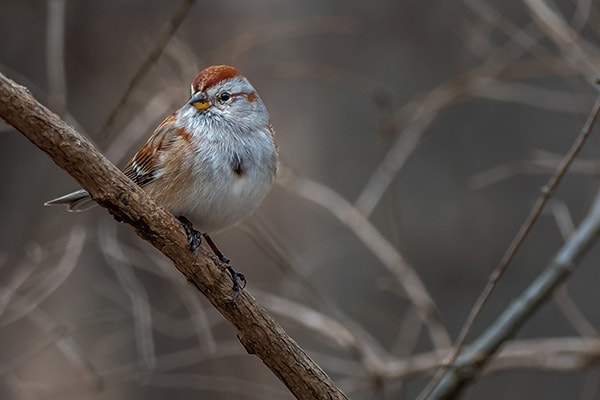
Differences In Summer Plumage vs Winter Plumage
American Tree Sparrows don’t also exhibit significant differences in plumage between summer and winter. However, in winter, these birds are observed to be buffer. You’ll also notice that the reddish-brown crown on their head forms a stripe at the center.
American tree sparrow bird vocalization
Where You’ll See American Tree Sparrows
American Tree Sparrows generally breed in the far north of Canada – Alaska, northern and central Quebec, south to the north of British Columbia, and Newfoundland. They are common visitors to the US when winter comes.
You’ll often see them along the edge of open tundras along the northern treeline, where trees and shrubs are scattered. During winter, you’ll see them in open forests, gardens, fields, marshes, and even residential areas.
American tree sparrow bird migration
American Tree Sparrows are what we call medium-distance migratory birds. So, they travel quite a distance going from north to south and vice versa.
Migration usually starts late fall and early spring at night. The birds will fly from their breeding point to the Northern and Central parts of North America for winter. Sometimes, they reach far south, going to northern Arizona, Alabama, and Texas.
American tree sparrow diet
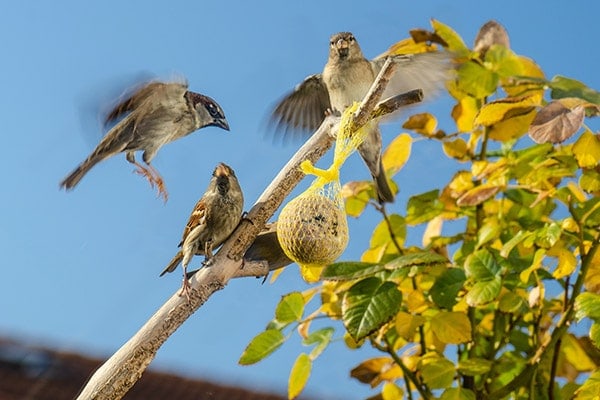
American Tree Sparrows are omnivores, which means they eat both plant and animal materials such as seeds, berries, and insects. But how much they eat would highly depend on the season.
- Winter: Entirely Seeds such as alder, blueberries, and cranberries
- Fall to Spring: Mostly grass and seeds with occasional insects and larvae
- Summer: Exclusively wide-variety of insects such as beetles, flies, leafhoppers, caterpillars, spiders, and snails
Protein-rich foods are essential for them in summer as it plays a huge role for the growth of their young. In contrast, they eat lots of seeds in the winter because it’s easier to find them.
You’ll find American Tree Sparrows search widely on the ground, low bushes, or even high up in trees for food when feeding. They are also usually seen in flocks, roaming around from one bird feeder to the next.
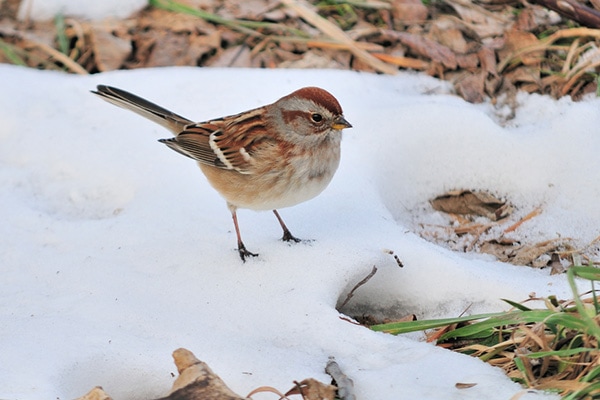
American tree sparrow nesting
- Clutch Size: 4-6 eggs
- # of Broods: 1 brood
- Incubation Period: 10-14 days
- Nestling period: 7 days
- Egg Description: Light blue with brownish spots
American Tree Sparrows are monogamous birds, so they mainly pair for life. These birds breed between May and September and raise only one brood every season.
The male American Tree Sparrow is the one who protects the territory while the female builds the nest. The nests are usually constructed on or near the ground. Often you’ll just see it on the grass, at the base of the shrub, or on a mossy hummock. The highest you’ll see of an American Tree Sparrow’s nest is at 4 feet.
You’ll identify the nest of these birds as an open cup composed of mosses, grasses, barks, and twigs. It is then lined with fine grass and feathers. This is usually built in just seven days.
American tree sparrow behavior
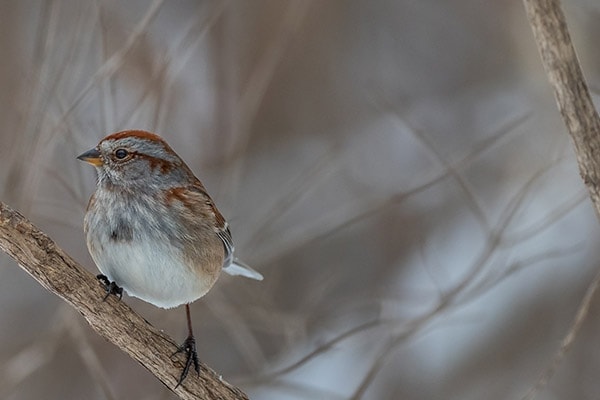
These birds are diurnal, which means they are most active during the day. However, when it’s time to migrate, they choose to travel at night.
In winter, you’ll see these birds forage in flocks. And though called American Tree Sparrows, the birds look for food on the ground, scratching snow and hoping over weeds and low branches, searching for berries.
Once the breeding season comes, the birds become territorial. Male American Tree Sparrows sing to claim their territories. They are also the ones in charge of defending the territories while the females stay with their young.
How-to attract american tree sparrows
Like any other birds, you can easily attract them if you provide them with all their needs – food, water, shelter, and even nesting sites. These birds mainly arrive in winter, so you need to provide fruits and seeds for them to eat during these times.
Since they mainly forage low, ground feeders are the most suitable to have. These will raise seeds above the snow and still leave them extra space to scratch and hop.
Besides the bird feeders, you should also provide some low covers. Deciduous shrubs and trees would be perfect. These shrubs will help protect these birds from any predators around, so make sure to place the bird feeder near here.
Finally, don’t forget to provide a sufficient water supply, too.
American tree sparrow threats
They are one of the least concerned birds in terms of conservation. They are very common, widespread, and have been known to adjust quickly to any habitat.
The birds have some known predators, such as hawks, owls, foxes, and red squirrels, but these do not really affect their numbers. However, some birds have been found to have high levels of arsenic compounds in their bodies due to some ongoing development in their local regions.
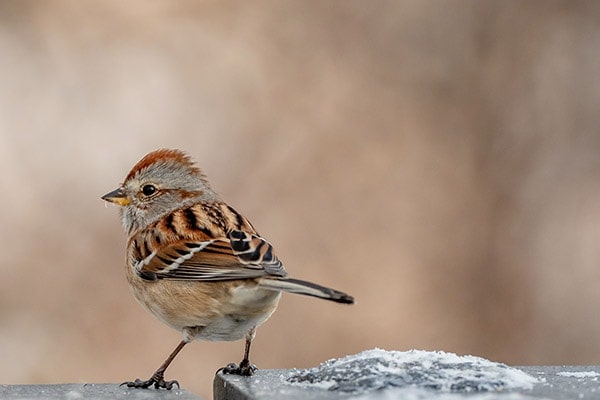
American tree sparrow fun & interesting facts
- These guys need to take in 30 percent of food and the same percentage of water every day to maintain their weight; fasting can then lead to death.
- Despite the name “tree” sparrow, the birds prefer to live in farmlands and rural gardens.
- There’s one study that showed that these birds watch their predators with their left eyes.
- A group of American Tree Sparrows is called “grove”.
- The birds feed 100% animal materials during winter, while they feed 100% on plant material during summer.
- The birds experienced a drastic decline, with only 10% left than their original number from 1960.
- Rufous-collared Sparrow
- Rufous-winged Sparrow
- Botteri’s Sparrow
- Cassin’s Sparrow
- Bachman’s Sparrow
- Grasshopper Sparrow
- Olive Sparrow
- Chipping Sparrow
- Clay-colored Sparrow
- Black-chinned Sparrow
- Field Sparrow
- Brewer’s Sparrow
- Black-throated Sparrow
- Lark Sparrow
- Lark Bunting
- Fox Sparrow
- Dark-eyed Juno
- Yellow-eyed Juno
- White-crowned Sparrow
- Golden-crowned Sparrow
- Harris’s Sparrow
- White-throated Sparrow
- Sagebrush Sparrow
- Bell’s Sparrow
- Vesper Sparrow
- LeConte’s Sparrow
- Seaside Sparrow
- Nelson’s Sparrow
- Saltmarsh Sparrow
- Savannah Sparrow
- Baird’s Sparrow
- Henslow’s Sparrow
- Song Sparrow
- Lincoln’s Sparrow
- Swamp Sparrow
- Canyon Towhee
- Albert’s Towhee
- California Towhee
- Green-tailed Towhee
- Spotted Towhee
- Eastern Towhee

